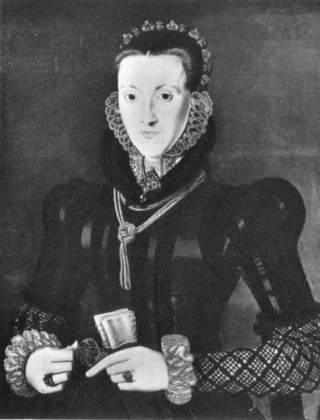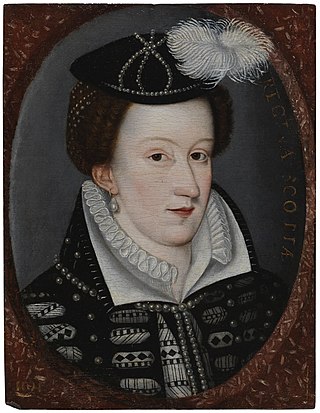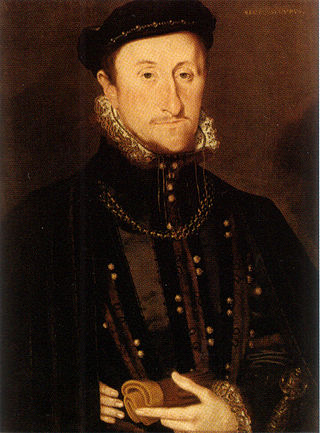Related Research Articles

The Battle of Langside was fought on 13 May 1568 between forces loyal to Mary, Queen of Scots, and forces acting in the name of her infant son James VI. Mary’s short period of personal rule ended in 1567 in recrimination, intrigue, and disaster when, after her capture at Carberry Hill, she was forced to abdicate in favour of James VI. Mary was imprisoned in Lochleven Castle, while her Protestant half-brother, James Stewart, Earl of Moray, was appointed Regent on behalf of his nephew. In early May 1568 Mary escaped, heading west to the country of the Hamiltons, high among her remaining supporters, and the safety of Dumbarton Castle with the determination to restore her rights as queen. Mary was defeated and went into exile and captivity in England. The battle is generally considered the start of the Marian civil war.
William Douglas, 6th Earl of Morton was the son of Robert Douglas of Lochleven and Margaret Erskine, a former mistress of James V of Scotland.

Sir William Kirkcaldy of Grange was a Scottish politician and soldier who fought for the Scottish Reformation. He ended his career holding Edinburgh castle on behalf of Mary, Queen of Scots and was hanged at the conclusion of a long siege.
Robert Richardson was a Scottish Prior of St Mary's Isle and royal administrator.

Agnes Keith, Countess of Moray was a Scottish noblewoman. She was the wife of James Stewart, 1st Earl of Moray, regent of Scotland and the illegitimate half-brother of Mary, Queen of Scots, making her a sister-in-law of the Scottish queen. As the wife of the regent, Agnes was the most powerful woman in Scotland from 1567 until her husband's assassination in 1570.
Katherine Bellenden was a courtier working in the wardrobe of James V of Scotland. Her niece of the same name was similarly employed.

The Marian civil war in Scotland (1568–1573) was a period of conflict which followed the abdication of Mary, Queen of Scots, and her escape from Lochleven Castle in May 1568. Those who ruled in the name of her infant son James VI fought against the supporters of the Queen, who was exiled in England. Edinburgh Castle, which was garrisoned in her name, became the focus of the conflict and surrendered only after an English intervention in May 1573. The conflict in 1570 was called an "internecine war in the bowels of this commonwealth", and the period was called soon after an "internecine war driven by questions against authority."
Hugh Montgomerie, 3rd Earl of Eglinton was a Scottish aristocrat who was a strong supporter of Mary Queen of Scots. He was an important participant in a tumultuous period of Scottish history.
James Stewart, 1st Lord Doune (1529-1590) was a Scottish landowner.
Sir John Gordon of Lochinvar and Kenmure, was a Scottish courtier, landowner, and supporter of Mary, Queen of Scots.
John Acheson was a Scottish goldsmith, mining entrepreneur, and official of the mint.

James Cockie was a goldsmith in Edinburgh. He helped mint coins in Edinburgh Castle during the Marian Civil War and was hanged as a counterfeiter on 3 August 1573.

The jewels of Mary, Queen of Scots (1542–1587), are mainly known through the evidence of inventories held by the National Records of Scotland. She was bought jewels during her childhood in France, adding to those she inherited. She gave gifts of jewels to her friends and to reward diplomats. When she abdicated and went to England many of the jewels she left behind in Scotland were sold or pledged for loans, first by her enemies and later by her allies. Mary continued to buy new jewels, some from France, and use them to reward her supporters. In Scotland her remaining jewels were worn by her son James VI and his favourites.
Alexander Clark of Balbirnie was a Scottish merchant and Provost of Edinburgh. He was closely involved with English diplomacy.
Archibald Stewart was a Scottish merchant and Provost of Edinburgh.

James Mosman or Mossman was a Scottish goldsmith. He and his son John Mosman were supporters of the cause of Mary, Queen of Scots. James Mosman was executed in 1573 for counterfeiting coins in Edinburgh Castle. John Mosman carried letters for Mary, Queen of Scots, and was under surveillance by Francis Walsingham.
Michael Gilbert was an Edinburgh goldsmith and financier.

Peter Sanderson was an Edinburgh tailor who worked for Anne of Denmark wife of James VI of Scotland.

James Barroun or Baron was a wealthy Scottish merchant based in Edinburgh and supporter of the Scottish Reformation.
James Gray was a Scottish goldsmith working in Edinburgh during the reigns of Mary, Queen of Scots and James VI of Scotland. Gray is known for the "Galloway mazer", a gilt cup now held by the National Museums of Scotland. He also engraved the brass plate for the tomb of Regent Moray in St Giles, Edinburgh.
References
- ↑ Michael Lynch, Edinburgh and the Reformation (Edinburgh, 1981), p. 52.
- ↑ G. How, 'Canongate Goldsmiths and Jewellers', Burlington Magazine, 74:435 (June 1939), p. 287.
- ↑ Michael Lynch, Edinburgh and the Reformation (Edinburgh, 1981), p. 52.
- ↑ W. Turnbull, Account of the families of Birnie by John Birnie (Edinburgh, 1838), pp. 2-3.
- ↑ Margaret Sanderson, 'Edinburgh Merchants', Renaissance and Reformation in Scotland (Scottish Academic Press, 1983), p. 187.
- ↑ David Masson, Register of the Privy Council, vol. 2, pp. 608-10.
- ↑ HMC 6th Report, Earl of Moray (London, 1877), pp. 643-4
- ↑ Margaret Sanderson, 'Edinburgh Merchants', Renaissance and Reformation in Scotland (Scottish Academic Press, 1983), p. 192.